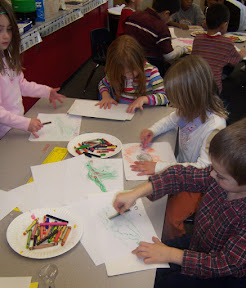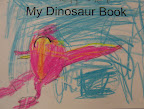Dinosaurs—a reason to draw and write
By Peggy Ashbrook
Posted on 2009-01-19
.jpg) Dinosaurs! This high-interest subject is a focus for questions relating to how animals live in many different environmental niches. What evidence do we have for what we think we know about dinosaurs? How do we know how they were shaped and how they lived? What was that body shape best suited for? What did they eat? Are there any animals alive today that evolved from dinosaurs? These questions can be related to animals the children may have experience with—how do we know a dog walked through the mud at the edge of the playground? What can a bird do that a squirrel can not? How does the shape of their bodies help them survive? An easy way to help young children draw dinosaur shapes is to draw a line of liquid glue over a line drawing on poster board. When the line of glue dries it will be ever-so-slightly raised, high enough to feel through a piece of paper with fingers or with a crayon held edgewise to make a rubbing.
Dinosaurs! This high-interest subject is a focus for questions relating to how animals live in many different environmental niches. What evidence do we have for what we think we know about dinosaurs? How do we know how they were shaped and how they lived? What was that body shape best suited for? What did they eat? Are there any animals alive today that evolved from dinosaurs? These questions can be related to animals the children may have experience with—how do we know a dog walked through the mud at the edge of the playground? What can a bird do that a squirrel can not? How does the shape of their bodies help them survive? An easy way to help young children draw dinosaur shapes is to draw a line of liquid glue over a line drawing on poster board. When the line of glue dries it will be ever-so-slightly raised, high enough to feel through a piece of paper with fingers or with a crayon held edgewise to make a rubbing.
.jpg) Details such as eyes, or feathers, can be added to this basic outline later with crayons, watercolor, or markers.
Details such as eyes, or feathers, can be added to this basic outline later with crayons, watercolor, or markers.
Young scientists ably copy long words—dinosaur names—getting practice with letter recognition and formation.
With a successful experience making a familiar dinosaur shape, reluctant artists are more comfortable drawing on their own.
 The American Museum of Natural History has online pages related to a 2005-2006 dinosaur exhibit. Teachers can visit a site by Glen J. Kuban for an overview of dinosaur tracks with drawings of sauropod, theropod, and ornithopod tracks (scroll down).
The American Museum of Natural History has online pages related to a 2005-2006 dinosaur exhibit. Teachers can visit a site by Glen J. Kuban for an overview of dinosaur tracks with drawings of sauropod, theropod, and ornithopod tracks (scroll down).
Happy tracking,
Peggy
Disclaimer: The views expressed in this blog post are those of the author(s) and do not necessarily reflect the official position of the National Science Teaching Association (NSTA).


